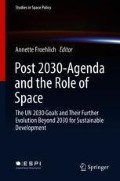Abstract
The world is running out of fresh water to support a growing population. Aquifers around the world on which whole communities depend are being depleted at a rapid rate. Apart from exploring new technologies to make more fresh water available, conservation efforts need to be stepped up—starting with awareness. Lack of awareness can seriously hamper water conservation efforts—take the example of Cape Town South Africa. The city is currently battling a severe water crisis that has put Cape Town on a road to a day, when the taps will literally run dry—“day zero”. The city stepped up efforts to create awareness of the increasingly dire situation through various channels. So why as of January 2018 with “day zero” two months away, has 60% of the city’s population still not adjusted their usage? The study of water consumption is an active field that has produced concepts like virtual water, water footprint and water accounting which all can help to provide a deeper understanding amongst users regarding the impact of their usage. Technology creates a potential opportunity to collect and present usage data in such a way as to influence user behaviour to favour a sustainable approach.
Access this chapter
Tax calculation will be finalised at checkout
Purchases are for personal use only
Notes
- 1.
Margaret Catley-Carlson as Vice-Chair of World Economic Forum.
- 2.
Gro Harlem Brundtland, Report of the World Commission on environment and development: “Our common future.” (UN, 1987).
- 3.
“Water, Sanitation and Hygiene” www.unicef.org/wash/ accessed 6 February 2018.
- 4.
“The Sustainable Development Agenda” www.un.org/sustainabledevelopment/development-agenda accessed 15 January 2018.
- 5.
“UN projects world population to reach 8.5 billion by 2030, driven by growth in developing countries” www.un.org/sustainabledevelopment/blog/2015/07/un-projects-world-population-to-reach-8-5-billion-by-2030-driven-by-growth-in-developing-countries/ accessed 15 January 2018.
- 6.
Ben Robinson, “Graphene sieve turns seawater into drinking water” 2017 University of Manchester News www.manchester.ac.uk/discover/news/graphene-sieve-turns-seawater-into-drinking-water accessed 3 February 2018.
- 7.
“Warka Tower” www.warkawater.org/warka-tower/ accessed 3 February 2018.
- 8.
“Aquastat Water withdrawal by sector, around 2007” 2014 Global Agriculture www.globalagriculture.org/fileadmin/files/weltagrarbericht/AquastatWithdrawal2014.pdf accessed 15 January 2018.
- 9.
“Aqueduct Country and River Basin Rankings” Aqueduct water risk indicators World Resources Institute www.wri.org/applications/maps/aqueduct-country-river-basin-rankings/ accessed 15 January 2018.
- 10.
Andrew Maddocks, “Water Stress by Country” 2013 World Resources Institute www.wri.org/resources/charts-graphs/water-stress-country accessed 15 January 2018.
- 11.
“Progress of goal 6 in 2017” 2017 Sustainable Development Goal 6 https://sustainabledevelopment.un.org/sdg6 accessed 3 February 2018.
- 12.
John Allan, ‘“Virtual water”: A long term solution for water short middle eastern economies?’ 1997 Water Issues Group, Sch. of Orient. and Afr. Stud., King's College, London, U. K.
- 13.
Oscar Tomasi, “‘Zero kilometre’ food products start to take Spain by storm” 2016, Euractive Agrifood www.euractiv.com/section/agriculture-food/news/sr-agri-local-zero-kilometre-products-start-to-take-spain-by-storm/ accessed 15 January 2018.
- 14.
“Virtual Water” http://virtualwater.eu/#about accessed 15 January 2018.
- 15.
Hoekstra, Arjen Y. “The water footprint: The relation between human consumption and water use.” In The water we eat, pp. 35–48. Springer, Cham, 2015.
- 16.
“National water footprint” Water Footprint Network http://waterfootprint.org/en/water-footprint/national-water-footprint/ accessed 6 February 2018.
- 17.
“Water” Sustainability https://www.conchaytoro.com/sustentabilidad/water/ accessed 5 February 2018.
- 18.
Daved Molden, and Ramaswamy. Sakthivadivel, 1999 “Water accounting to assess use and productivity of water.” International Journal of Water Resources Development 15, no. 1–2 (1999): 55–71.
- 19.
Klaus Schwab, “The Fourth Industrial Revolution: what it means, how to respond” 2016 WEF https://www.weforum.org/agenda/2016/01/the-fourth-industrial-revolution-what-it-means-and-how-to-respond/ accessed 15 January 2018.
- 20.
Andrew Cave, “What Will We Do When The World's Data Hits 163 Zettabytes In 2025?” 2017 Forbes www.forbes.com/sites/andrewcave/2017/04/13/what-will-we-do-when-the-worlds-data-hits-163-zettabytes-in-2025/ accessed 5 February 2018.
- 21.
Carol Rasmussen, “GRACE Mission: 15 Years of Watching Water on Earth” 2017 NASA Earth Science News Team www.nasa.gov/feature/jpl/grace-mission-15-years-of-watching-water-on-earth accessed 15 January 2018.
- 22.
“Next-Generation GRACE Satellites Arrive at Launch Site” 2017 https://gracefo.jpl.nasa.gov/news/122/next-generation-grace-satellites-arrive-at-launch-site/ accessed 6 February 2018.
- 23.
Doug Messier, “SpaceX Wants to Launch 12,000 Satellites” 2017 Parabolic Arc www.parabolicarc.com/2017/03/03/spacex-launch-12000-satellites/ accessed 6 February 2018.
- 24.
Patrick Nelson, “We touch our phones 2617 times a day, says study” 2016 NetworkWorld www.networkworld.com/article/3092446/smartphones/we-touch-our-phones-2617-times-a-day-says-study.html accessed 6 February 2018.
- 25.
RecycleBank www.recyclebank.com/ accessed 6 February 2018.
- 26.
John Elkington, “Partnerships from cannibals with forks: The triple bottom line of 21st‐century business.” 1998 Environmental Quality Management 8, no. 1 (1998): 37–51.
- 27.
Samuel Topping and others, “Framework for Cyber-Physical Systems: Volume 1, Overview” NIST 2017.
Author information
Authors and Affiliations
Corresponding author
Editor information
Editors and Affiliations
Rights and permissions
Copyright information
© 2018 Springer International Publishing AG, part of Springer Nature
About this chapter
Cite this chapter
Kotze, C. (2018). Towards Total Water Awareness: A Technology Framework. In: Froehlich, A. (eds) Post 2030-Agenda and the Role of Space. Studies in Space Policy, vol 17. Springer, Cham. https://doi.org/10.1007/978-3-319-78954-5_3
Download citation
DOI: https://doi.org/10.1007/978-3-319-78954-5_3
Published:
Publisher Name: Springer, Cham
Print ISBN: 978-3-319-78953-8
Online ISBN: 978-3-319-78954-5
eBook Packages: Social SciencesSocial Sciences (R0)

